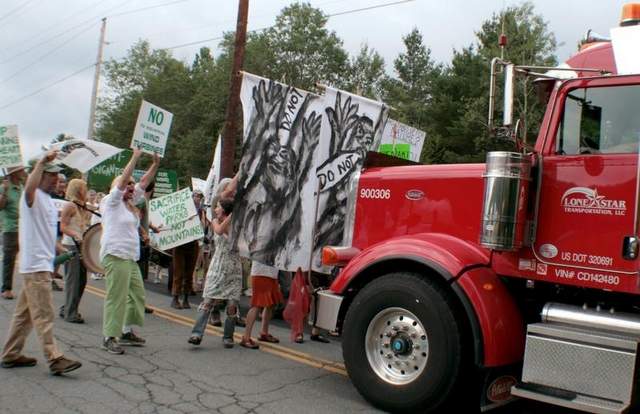9/28/09 What's this about the Wind Farm Strong Arm in Michigan?
“Opponents say tighter restrictions are needed. The wind industry says tougher rules will keep wind farms out of Michigan.”

Homeowners fight against the wind
Turbines blow ill wind for some
BY TINA LAM
[CLICK HERE TO READ AT SOURCE: DETROIT FREE PRESS ]
PIGEON -- In the Champagne household, there are two opinions on the whirling wind turbines that surround the family's home of 35 years. Gene Champagne is bothered by the thumping, rumbling sound of the blades that loom like giants over the house. The noise disturbs his sleep and destroys his TV reception. Flickering shadows from sun on the blades run around rooms.
His wife, Betty, says she thinks the towers are fine. "They're majestic," she said. "But I'm bothered because it bothers him."
While turbines are good for the environment and for farmers who reap thousands of dollars a year from leasing their land to wind firms, some neighbors aren't happy. They say towers sound like jet engines overhead that never leave and they can feel the vibrations in their chests.
Opponents say tighter restrictions are needed. The wind industry says tougher rules will keep wind farms out of Michigan.
Neighbors object to noise, proximity and seek more limits
On a wind map of Michigan, Huron County is the bull's-eye.
The county hosts the state's two commercial wind farms. Besides good winds, it has wind-friendly policies and plenty of agricultural land. Farmers who lease acreage to wind companies are thrilled with the extra cash, which amounts to several thousand dollars a year and sometimes five figures.
County Zoning and Planning Director Russ Lundberg expects 700-1,000 turbines in the next few years, compared with 78 now. "We want them," he said.
State officials have bigger dreams: as many as 2,800 twirling towers in the Thumb and another 1,200 in west Michigan. Gov. Jennifer Granholm wants to make Michigan the nation's 14th windiest state, a big player in wind power to attract green jobs and investment.
But in Huron County and elsewhere in the state, residents who have turbines as neighbors are pushing back.
Wind farms have generated anger, tension and conflict, even in places that don't have any yet. The issues are height, how close turbines can be to homes, property values, flickering shadows from blades and noise.
Ten Huron County residents have filed formal complaints about turbine noise. They say the county's zoning allows towers too close to homes. Some have "No Wind" signs on their lawns.
Those complaints, and others across the country, are being watched closely by people in areas targeted for giant turbines.
In Lake Township at the tip of the Thumb, two commissioners were tossed off the local zoning board earlier this month for slander and misfeasance after they pushed an ordinance that would restrict turbines. A board member who voted to remove them has leased his land for a future DTE Energy wind farm.
"It's pitting neighbor against neighbor," said Valerie McCallum, clerk of Lake Township.
Some governments, like Centerville and Leelanau townships in Leelanau County, have or are working on zoning that wouldn't allow commercial-size turbines, which can be as high as a 30-story building. Others, like Ann Arbor Township and Paris Township in the Thumb, have moratoriums on turbines until they hammer out regulations.
Some see the state as the 800-pound gorilla in the debate. They say state wind zoning guidelines, developed by an informal working group with industry input in 2005, are too lax. The guidelines have no height restriction and allow turbines 300-400 feet from homes, a little more than the length of a football field. Even pro-wind Huron County requires more space -- 1,000 feet -- from homes.
John Sarver, chairman of the Michigan Wind Working Group, which came up with the state guidelines, said he thinks the real issue isn't noise but the visual impact of turbines. "We don't necessarily outlaw certain developments based on individuals' reactions," he said.
If local governments pass too many restrictions, the state Legislature could step in and dictate standards statewide, Lundberg said. That happened in Wisconsin, where the state's public utility commission now sets requirements for wind farms.
"It's a huge challenge," Lundberg said of trying to balance the interests of farmers, who want turbines because they bring in thousands of dollars a year in income, and neighbors who are bothered by them.
'It's affecting our health'
When David Peplinski found out wind turbines were coming to Ubly, he heard that they would be no louder than a clothes dryer. Instead, several nights a week, the noise drives him and his family from the house he spent five years restoring. They rent an apartment where they sleep. "It's affecting our health," he said. "When my wife and kids sleep there, they feel much better."
From the kitchen sink of what was once his grandparents' home, he sees turbines in two directions. The closest one is 1,300 feet, about a quarter-mile away. At its worst, the blades sound like a helicopter parked overheard. Peplinski said he can feel the low-frequency vibrations, as well as hear the sound. The county's sound limit is 50 decibels, but officials have no way to check compliance.
Peplinski filed a formal complaint with the county over the noise, as did his father, who lives nearby. In mid-October, a firm hired by John Deere, which owns all 78 turbines in the county, will do sound testing at people's homes, said planner Lundberg.
Peplinski and others troubled by the noise say putting turbines a mile away would help with noise issues, as well as the flickering shadows cast when sun hits the blades at certain angles.
That would mean fewer turbines in a given area, which doesn't make wind companies happy. Joe DeVito, vice president of RES Americas, which hopes to put 250-300 turbines in Huron County, said setbacks of a mile "would mean we're probably not going to do wind in this state."
Peplinski, who comes from a farm family, said he thinks too many people are blinded by the money turbines bring. He's frustrated that his concerns have been ignored.
"I understand the economics of this, the need for income," Peplinski said. "What I don't understand is their unwillingness to take what I say as valid."
Rick James, an acoustic expert in Okemos who has done pre- and post-turbine testing for some homeowners, said there are noise complaints across the country at commercial wind farms, including in the province of Ontario, which plans to require further setbacks from houses.
James said some people are more sensitive to sound than others, and that there are large variations in geography and even the size of rooms in a house that affect what they hear. "There are people in every community that aren't bothered, and those that are," he said. "If people are getting ill and not sleeping, it's not good."
James said in a 2006 report before any turbines went up that the state and Huron County's noise limits were seriously flawed, ignored advice from a technical expert and would lead to complaints from people in the once-quiet rural area.
'We have to make the best of it'
Angie Weber, her husband, Randy, and their four kids have ended family campouts in a tent in their yard, a favorite summer activity, after wind turbine noise drove them inside this summer. No one slept well; the kids needed naps.
Even when she's out running, wearing earphones, Weber can hear the blades. The sound changes often, as the blades alter direction.
"We don't have an option of packing up and leaving; we have to make the best of it," she told a state board in August. "Our entire lives' investment is here." Her husband farms sugar beets, corn, wheat and hay and raises beef cattle outside Ubly.
Even before 46 new turbines went up in the fall of 2008, Weber and others collected more than 1,800 signatures on petitions to put the county wind turbine zoning to a vote, but a judge ruled the petitions invalid. "Some of us had done research and were concerned about the setbacks," she said. "We thought they were too close."
She had acoustic expert James do testing at her home before the turbines, and he found that at night, the ambient sound was in the high 20 decibel range, quieter than some acoustic testing labs.
Now, the turbine across the road on a neighbor's farm is allowed to go up to 50 decibels at night.
Planner Lundberg said his county may revisit setbacks and noise levels for future projects but won't do anything that would drive wind companies away. "What happens if, because of 10 written complaints, we change our standards to a point where it doesn't look like wind could work here?" he said.
"If we can't make it work here, it's not going to work anywhere in Michigan."
Energy board's 1 public advocate now works for wind firm
Those who live closest to Michigan's existing wind turbines say their concerns are often ignored because officials of local government either have leased their land to wind farms or live in areas that won't get wind development.
Huron County Zoning and Planning Director Russ Lundberg, a wind power advocate, lives on Sand Point, a tiny finger of land on the county's northern tip too skinny to fit turbines -- unless they end up offshore, he noted.
A state board, the Michigan Wind Energy Resource Zone board, which is examining where the best areas of the state are for wind, has 11 members. No members, however, are from Huron County, the only place in the state so far with sizable wind farms.
Five board members represent the wind industry: utilities planning wind farms, wind developers, electricity transmission firms and alternative energy companies. The other members represent environmental groups, the attorney general, townships and cities.
The lone member chosen to represent the public, Mary Templeton, didn't work for a wind firm when appointed in 2008, but she does now.
Templeton is listed as vice president of sales for Wind Energy Consulting & Contracting, a Florida firm, in various news releases since August.
In e-mails to the Free Press, Templeton said her company focuses on smaller wind projects rather than large commercial-size ones, so she doesn't see a problem. "I see no reason why there would be any conflict of interest, however, I will respectfully abstain from any vote that ... represents a conflict of interest," she said.
The home page for Templeton's company says: "We deliver the total package for wind energy projects large and small. ... Small to utility scale. We do it all."
Carolyn Weed lives in Centerville Township in Leelanau County, which the state wind board has targeted for wind development. She was stunned to hear about Templeton's new job. "Are you kidding me?" she said. "Then there's nobody representing the public."
 Yard sign near Ulby, MichiganNOTE FROM THE BPWI RESEARCH NERD: The person who sent us the link to this story asks a good question:
Yard sign near Ulby, MichiganNOTE FROM THE BPWI RESEARCH NERD: The person who sent us the link to this story asks a good question:
"Will public health and safety ever be acknowledged when it comes to siting industrial wind turbines? There appears to only be one choice. If you want wind development in a state you need to ignore the health and safety of non-participating landowners and keep installing industrial wind turbines too close to people’s homes."
CLICK HERE TO READ "WHAT'S THE LATEST? TURBINES IN THE NEWS"